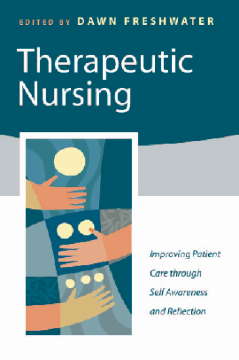
Additional Information
Book Details
Abstract
'I found the book to be fascinating and so thought provoking that it made me consider more carefully the text and prose to really understand what the author said. It is skilfully written, very readable and has implications for a wide range of people such as the undergraduate, practitioner, lecturer and researcher' - Accident and Emergency Nursing
Gaining self-awareness is a vital aspect of professional development for all who work in the caring professions. In nursing especially, the ability to evaluate oneself affects all areas of practice, including direct patient care, working relationships with colleagues and maintaining one's own well-being in the often pressured environment of health care.
This is an innovative text which explores the ways in which self-awareness can be used as a practical tool for continuing professional development and practice improvement. Divided into three parts, the book examines the role of the nurse as therapeutic practitioner, reflective learner and reflexive researcher.
For all those wishing to develop their skills as autonomous, reflective, accountable practitioners, this book will be an inspiring read. It will be of immense use to those who teach and supervise nurses at all levels.
Table of Contents
| Section Title | Page | Action | Price |
|---|---|---|---|
| Prelims [About the authors |Foreword |Preface |Acknowledgements |Abbreviations and acronyms | Key people in the history of AMK] | |||
| Prologue: Seila’s story | |||
| Introduction: Going beyond good intentions | |||
| Building a business model for good | |||
| Does it work? | |||
| A brief history | |||
| Part I Shedding assumptions about clients | |||
| Meeting needs as well as wants | |||
| Ensuring access | |||
| Balancing the needs of different groups | |||
| Chapter 1 Insight: Don’t just offer products; respond to client needs | |||
| Understanding client livelihoods | |||
| Designing products that respond to needs | |||
| Looking ahead | |||
| Chapter 2 Insight: Ask good questions; have good conversations | |||
| Asking good questions | |||
| Having good conversations | |||
| Using data better | |||
| Looking ahead | |||
| Part II Translating good intentions | |||
| Managing what matters | |||
| The end of ‘command and control’ | |||
| Chapter 3 Insight: Do what it says on the tin | |||
| Laying the foundation for growth | |||
| Stress testing the model | |||
| Learning the lessons | |||
| Looking ahead | |||
| Chapter 4 Insight: Motivate staff to do difficult work in an excellent way | |||
| Creating a learning culture | |||
| Supporting the learning culture | |||
| Building the right Board to deliver value | |||
| Looking ahead | |||
| Part III Building a business model that works | |||
| Choosing the dirt road | |||
| An evolving business model | |||
| Chapter 5 Insight: Own the dirt road | |||
| At war with conventional wisdom | |||
| AMK’s ‘outside-in’ strategy | |||
| Making the maths work | |||
| Maintaining a focus on poor people | |||
| Looking ahead | |||
| Chapter 6 Insight: Adapt to the changing landscape | |||
| Balancing your offering with capacity and context | |||
| The dangers of standing still | |||
| Exploring the limits of the product offering | |||
| The savings story: Bringing it all together | |||
| Looking ahead | |||
| Conclusions: Taking the road less travelled | |||
| How can we do better at doing good? | |||
| One organization in a big world | |||
| Looking forward |
